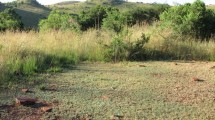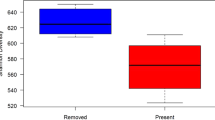Abstract
The decomposition of vertebrate cadavers on the soil surface produces nutrient-rich fluids that enter the soil profile, leaving clear evidence of the presence of a cadaver decomposition island. Few studies, however, have described soil physicochemistry under human cadavers, or compared the soil between human and non-human animal models. In this study, we sampled soil to 5 cm depth at distances of 0 cm and 30 cm from cadavers, as well as from control sites 90 cm distant, from five human and three pig cadavers at the Australian Facility for Taphonomic Experimental Research (AFTER). We found that soil moisture, electrical conductivity, nitrate, ammonium, and total phosphorus were higher in soil directly under cadavers (0 cm), with very limited lateral spread beyond 30 cm. These patterns lasted up to 700 days, indicating that key soil nutrients might be useful markers of the location of the decomposition island for up to 2 years. Soil phosphorus was always higher under pigs than humans, suggesting a possible difference in the decomposition and soil processes under these two cadaver types. Our preliminary study highlights the need for further experimental and replicated research to quantify variability in soil properties, and to identify when non-human animals are suitable analogues.




Similar content being viewed by others
References
Dent BB, Forbes SL, Stuart BH. Review of human decomposition processes in soil. Environ Geol. 2004;45:576–85.
Vass AA, Bass WM, Wolt JD, Foss JE, Ammons JT. Time since death determination of human cadavers using soil solution. J Forensic Sci. 1992;37:1236–53.
Carter DO, Yellowlees D, Tibbett M. Cadaver decomposition in terrestrial ecosystems. Naturwissenschaften. 2007;94:12–24.
Fancher JP, Aitkenhead-Peterson JA, Farris T, Mix K, Schwab AP, Wescott DJ, et al. An evaluation of soil chemistry in human cadaver decomposition islands: potential for estimating postmortem interval (PMI). Forensic Sci Int. 2017;279:130–9.
Perrault KA, Forbes SL. Elemental analysis of soil and vegetation surrounding decomposing human analogues. Can Soc Forensic Sci J. 2016;49:138–51.
Keenan SW, Schaeffer SM, Jin VL, DeBruyn JM. Mortality hotspots: nitrogen cycling in forest soils during vertebrate decomposition. Soil Biol Biochem. 2018;121:165–76.
Benninger LA, Carter DO, Forbes SL. The biochemical alteration of soil beneath a decomposing carcass. Forensic Sci Int. 2008;180:70–5.
Luong S, Forbes SL, Wallman JF, Roberts RG. Monitoring the extent of vertical and lateral movement of human decomposition products through sediment using cholesterol as a biomarker. Forensic Sci Int. 2018;285:93–104.
Finley SJ, Pechal JL, Benbow ME, Robertson BK, Javan GT. Microbial signatures of cadaver gravesoil during decomposition. Microb Ecol. 2016;71:524–9.
Singh B, Minick KJ, Strickland MS, Wickings KG, Crippen TL, Tarone AM, et al. Temporal and spatial impact of human cadaver decomposition on soil bacterial and arthropod community structure and function. Front Microbiol. 2018;8:2616.
Aitkenhead-Peterson JA, Owings CG, Alexander MB, Larison N, Bytheway JA. Mapping the lateral extent of human cadaver decomposition with soil chemistry. Forensic Sci Int. 2012;216:127–34.
Quaggiotto MM, Evans MJ, Higgins A, Strong C, Barton PS. Dynamic soil nutrient and moisture changes under decomposing vertebrate carcasses. Biogeochemistry. 2019;146:71–82.
Macdonald BCT, Farrell M, Tuomi S, Barton PS, Cunningham SA, Manning AD. Carrion decomposition causes large and lasting effects on soil amino acid and peptide flux. Soil Biol Biochem. 2014;69:132–40.
Forbes SL, Shareef M. Establishing the first human decomposition facility in Australia. Forensic Sci Int. 2017;277:157.
Parmenter RR, MacMahon JA. Carrion decomposition and nutrient cycling in a semiarid shrub-steppe ecosystem. Ecol Monogr. 2009;79:637–61.
Knobel Z, Ueland M, Nizio KD, Patel D, Forbes SL. A comparison of human and pig decomposition rates and odour profiles in an Australian environment. Aust J Forensic Sci. 2018;51:557–72.
Matuszewski S, Hall MJR, Moreau G, Schoenly KG, Tarone AM, Villet MH. Pigs vs people: the use of pigs as analogues for humans in forensic entomology and taphonomy research. Int J Legal Med. 2020;134:793–810.
Dautartas A, Kenyhercz MW, Vidoli GM, Meadows Jantz L, Mundorff A, Steadman DW. Differential decomposition among pig, rabbit, and human remains. J Forensic Sci. 2018;63:1673–83.
Rayment GE, Higginson FR. Australian laboratory handbook of soil and water chemical methods. Melbourne: Inkata Press; 1992.
Matejovic I. Determination of carbon and nitrogen in samples of various soils by the dry combustion. Commun Soil Sci Plant Anal. 1997;28:1499–511.
Diamond DD. QuikChem method 13-115-01-1-B. Determination of total Kjeldahl phosphorus in soils and plants by flow injection analysis. In: Lachat applications in standard methods. Lachat Instruments, Milwaukee; 2006.
Steadman DW, Dautartas A, Kenyhercz MW, Jantz LM, Mundorff A, Vidoli GM. Differential scavenging among pig, rabbit, and human subjects. J Forensic Sci. 2018;63:1673–83.
Towne EG. Prairie vegetation and soil nutrient responses to ungulate carcasses. Oecologia. 2000;122:232–9.
Barton PS, McIntyre S, Evans MJ, Bump JK, Cunningham SA, Manning AD. Substantial long-term effects of carcass addition on soil and plants in a grassy eucalypt woodland. Ecosphere. 2016;7:e01537.
Wallman JF. Body farms. Forensic Sci Med Pathol. 2017;13:487–9.
Acknowledgements
We are indebted to the donors involved in research at AFTER and to the invaluable contribution they have made to forensic science. We thank all UTS staff and students who assisted with donor acquisition and placement. Natasha Mansfield assisted with soil sample preparation. Andrew Higgins provided expert technical advice on soil analytical procedures. PSB received funding from the Australian Research Council (DE150100026).
Statement of author contributions
PB, CS, BD, MU and JW contributed to the study conception and design. Material preparation, data collection and laboratory and data analysis were performed by PB, AR, and BD. PB wrote the first draft of the manuscript and all authors commented on versions of the manuscript. All authors read and approved the final manuscript.
Author information
Authors and Affiliations
Corresponding author
Ethics declarations
Conflict of interest
The authors declare no potential conflicts of interest. Research described in this manuscript involved deceased humans and animals. The human cadavers were delivered through the UTS body donation program, approved by the UTS Human Research Ethics Committee Program Approval (UTS HREC REF No. ETH15–0029). Pigs were purchased post-mortem from a licensed abattoir, therefore requiring no ethics approval in accordance with the Australian Code of Practice for the Care and Use of Animals for Scientific Purposes (2004).
Additional information
Publisher’s note
Springer Nature remains neutral with regard to jurisdictional claims in published maps and institutional affiliations.
Electronic supplementary material
ESM 1
(PDF 82 kb)
Rights and permissions
About this article
Cite this article
Barton, P.S., Reboldi, A., Dawson, B.M. et al. Soil chemical markers distinguishing human and pig decomposition islands: a preliminary study. Forensic Sci Med Pathol 16, 605–612 (2020). https://doi.org/10.1007/s12024-020-00297-2
Accepted:
Published:
Issue Date:
DOI: https://doi.org/10.1007/s12024-020-00297-2




